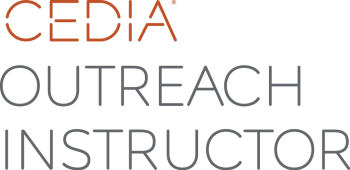Industry Education
Enhance Your Knowledge and Stay Ahead Of The Curve

As a CEDIA Outreach Instructor, Atlanta Audio & Automation helps you stand out from the competition by keeping you informed about the latest custom technology trends on both the residential and commercial markets. Learn about every aspect of home technology from custom theater design and video surveillance to wiring installation and integrated systems. Along with CEDIA, there are many other organizations like Lutron Electronics which we partner with to bring you the latest in technology trends like lighting control and hidden technologies that can be part of your design elements.
With the right training, you will be prepared to answer any questions from prospective clients. These courses can also be used towards continuing education credits when renewing your designer, architect or construction licenses.
In order to become CEDIA Outreach Instructors, we underwent a comprehensive “Train the Trainer” course and have to follow strict guidelines to retain our COI status. In addition to this, we boast more than 20 years of experience in the custom electronics design and integration industry. We know how busy your schedule can get, which is why we set up the courses in your office or showroom for optimal convenience. Read on to learn more about the many diverse courses we have to offer, and fill out the form to the right to sign up.
Learn More

COURSE DESCRIPTIONS
COURSE 1: CONTROLLING AND ISOLATING SOUND IN THE DESIGN AND CONSTRUCTION PROCESS
COURSE 2: DEDICATED THEATER DESIGN
COURSE 3: DISGUISE AND HIDE - DESIGNING FOR TECHNOLOGY
COURSE 4: LIGHTING CONTROL ILLUMINATED
COURSE 5: PROPER PLANNING FOR RESIDENTIAL ELECTRONIC SYSTEMS
COURSE 6: SHADE AND WINDOW TREATMENTS OVERVIEW – MOTORIZE, AUTOMATE AND INTEGRATE
COURSE 7: SUPPORTING GREEN LIFESTYLES WITH TECHNOLOGY SYSTEMS
COURSE 8: TECHNOLOGY SYSTEMS AND PRODUCTS FOR OUTDOOR SPACES
COURSE 9: UNDERSTANDING TODAY’S HOME TECHNOLOGY AND INFRASTRUCTURE OPTIONS
COURSE 10: The Lighting Renaissance I AIA Program # LRI15 (1.0 LU) IDCEC (ASID/IIDA) Approved (0.1 CEU)
Objectives:
- Explain how to control electric and daylight through switching, dimming, and shading technologies
- Distinguish the difference between the basic lamp types and explain how they are controlled
- Identify proper lighting control strategies to ensure space aesthetics, efficiency, and occupant comfort
- List the variety of window treatments and how they effectively control daylight
COURSE 11: The Lighting Renaissance II AIA Program # LRII15 (1.0 LU) IDCEC (ASID/IIDA) Approved (0.1 CEU)
Objectives:
- Explain dimming technology; lighting loads, configurations, ganging and derating
- Recognize the difference between single zone, single room, and whole home lighting control strategies
- Demonstrate when to use localized, centralized, or optimized whole home lighting control system
- Describe how effective daylight management plays an integral role in a total home control system to increase occupant comfort and save energy
COURSE 12: From Vision to reality; Where technology meets design. AIA Approved IDCEC (ASID/IIDA) Approved
Objectives:
- How to retain your design vision, while keeping technology in your project portfolio
- Design impact of technology components across the project
- Elements: Permanent, Transitional & Temporary
- Technology: Its expanded presence
- Impact: How your vision gets compromised
- Harmony: How to include technology components in real world design